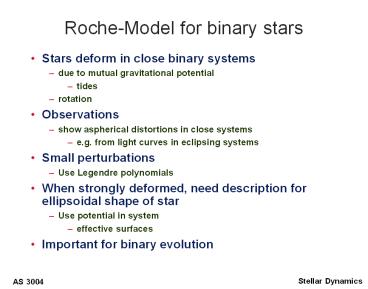Roche-Model for binary stars - PowerPoint PPT Presentation
Title:
Roche-Model for binary stars
Description:
Roche-Model for binary stars. Stars deform in close binary systems ... Roche-lobes:: surfaces which just touch at L1. maximum size of non-contact systems ... – PowerPoint PPT presentation
Number of Views:150
Avg rating:3.0/5.0
Title: Roche-Model for binary stars
1
Roche-Model for binary stars
- Stars deform in close binary systems
- due to mutual gravitational potential
- tides
- rotation
- Observations
- show aspherical distortions in close systems
- e.g. from light curves in eclipsing systems
- Small perturbations
- Use Legendre polynomials
- When strongly deformed, need description for
ellipsoidal shape of star - Use potential in system
- effective surfaces
- Important for binary evolution
2
Potential in close binaries
P(x,y,z)
- C centre of mass
- reference frame centred on more massive star m1
- rotating with angular velocity w, same as binary
system - circular orbit
- Potential at P(x,y,z) is then
r1
r2
y
m1
m2
C
x
z
3
- if we normalise to a 1
- then we can define
- the normalised gravitational potential,
- and the mass ratio
4
Equipotential surfaces
- The total potential may then be calculated at any
point P with respect to the binary system. - Surfaces of constant potential may be found
- shape of stars is given by these equipotential
surfaces - Deformation from spherical depends on size
relative to semi major axis, a, and mass ratio q
5
Roche Lobes
- Lagrange points L1, L2, L3, and L4, L5
6
Lagrange points
- Points where
- L1 - Inner Lagrange Point
- in between two stars
- matter can flow freely from one star to other
- mass exhange
- L2 - on opposite side of secondary
- matter can most easily leave system
- L3 - on opposite side of primary
- L4, L5 - in lobes perpendicular to line joining
binary - form equilateral triangles with centres of two
stars - Roche-lobes surfaces which just touch at L1
- maximum size of non-contact systems
7
Roche potential wells
8
Types of Binaries
- Detached systems
- Inside Roche-lobes
- Semi-detached systems
- at least one star filling its Roche-lobe
- Contact systems
- two stars touching at inner lagrange point L1
- Over-Contact systems
- two stars overfilling Roche-lobes
- neck of material joining them
- Common-envelope systems
- Two stars have one near-spherical envelope
- R gtgt a
9
Binaries in Roche-Lobes
10
Inner Lagrange point
- to find L1
- for which a solution for x1 can be found
numerically for a given mass ratio q
11
Roche-Lobe
- Effective size
- radius of Roche-lobe RL
- find by numerical integration of potential
- Effectively, it is a tidal radius where
- densities in lobes are equal

